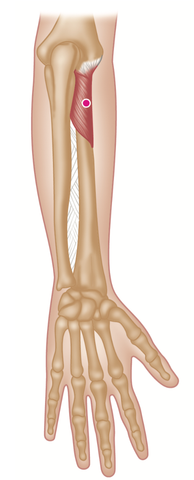Trigger Point Release - Supinator Muscle
Supinator Trigger Points - Dr. Jonathan Kuttner
Trigger Points in the Supinator Muscles are Too Often Overlooked As The Muscle Lies Deep and "Concealed" - They are Often Associated with Elbow Pain.
The supinator is associated with deceleration of the elbow during extension. When the forearm is held between supination and pronation, the supinator will decelerate elbow extension.
The supinator is a lateral elbow pain generator. The muscle sneaks pain down into the web of the thumb on the dorsal side.
Changes in sensations include, but are not limited to, numbness and weakness in the hand (which may be due to compression of the deep branch of the radial nerve—the posterior interosseous nerve) and in the fingers.
Part of the deep group. The supinator is almost entirely concealed by the superficial muscles.

Supinator - Common Trigger Point Site
ORIGIN
Lateral epicondyle of humerus. Radial collateral (lateral) ligament of elbow joint. Annular ligament of superior radioulnar joint. Supinator crest of ulna.
INSERTION
Dorsal and lateral surfaces of upper third of radius.
ACTION
Supinates forearm (for which it is probably the main prime mover, with biceps brachii being an auxiliary). Antagonists: pronator teres, pronator quadratus.
NERVE
Deep radial nerve, C5, 6, (7). BASIC FUNCTIONAL
MOVEMENT
Example: turning a door handle or screwdriver.
REFERRED PAIN PATTERNS
Localized 3–5 cm strong zone of pain at lateral epicondyle and at the web of the thumb (dorsum).
INDICATIONS
Tennis elbow, thumb joint pain, elbow pain (when carrying and at rest), pain turning doorknobs, localized pain on supination, chronic use of walking stick, pain on handshake.
CAUSES
Repetitive motions with straight arm (e.g. tennis, dog walking, carrying heavy case), repetitive motions (e.g. twisting, massaging, driving, ironing), trauma/strain, racquet sports.
DIFFERENTIAL DIAGNOSIS
De Quervain’s tenosynovitis. Lateral epicondylitis (tendo-osseous, musculotendinous, intramuscular). Radial head dysfunction.
CONNECTIONS
Common extensors, biceps brachii, triceps brachii (insertion), anconeus, brachialis, palmaris longus, brachioradialis, extensor carpi radialis longus.
Find a Trigger Point Professional in your area
Dry Needling for Trigger Points
This trigger point therapy blog is intended to be used for information purposes only and is not intended to be used for medical diagnosis or treatment or to substitute for a medical diagnosis and/or treatment rendered or prescribed by a physician or competent healthcare professional. This information is designed as educational material, but should not be taken as a recommendation for treatment of any particular person or patient. Always consult your physician if you think you need treatment or if you feel unwell.


About Niel Asher Education
Niel Asher Education (NAT Global Campus) is a globally recognised provider of high-quality professional learning for hands-on health and movement practitioners. Through an extensive catalogue of expert-led online courses, NAT delivers continuing education for massage therapists, supporting both newly qualified and highly experienced professionals with practical, clinically relevant training designed for real-world practice.
Beyond massage therapy, Niel Asher Education offers comprehensive continuing education for physical therapists, continuing education for athletic trainers, continuing education for chiropractors, and continuing education for rehabilitation professionals working across a wide range of clinical, sports, and wellness environments. Courses span manual therapy, movement, rehabilitation, pain management, integrative therapies, and practitioner self-care, with content presented by respected educators and clinicians from around the world.
Known for its high production values and practitioner-focused approach, Niel Asher Education emphasises clarity, practical application, and professional integrity. Its online learning model allows practitioners to study at their own pace while earning recognised certificates and maintaining ongoing professional development requirements, making continuing education accessible regardless of location or schedule.
Through partnerships with leading educational platforms and organisations worldwide, Niel Asher Education continues to expand access to trusted, high-quality continuing education for massage therapists, continuing education for physical therapists, continuing education for athletic trainers, continuing education for chiropractors, and continuing education for rehabilitation professionals, supporting lifelong learning and professional excellence across the global therapy community.

Continuing Professional Education
Looking for Massage Therapy CEUs, PT and ATC continuing education, chiropractic CE, or advanced manual therapy training? Explore our evidence-based online courses designed for hands-on professionals.



















